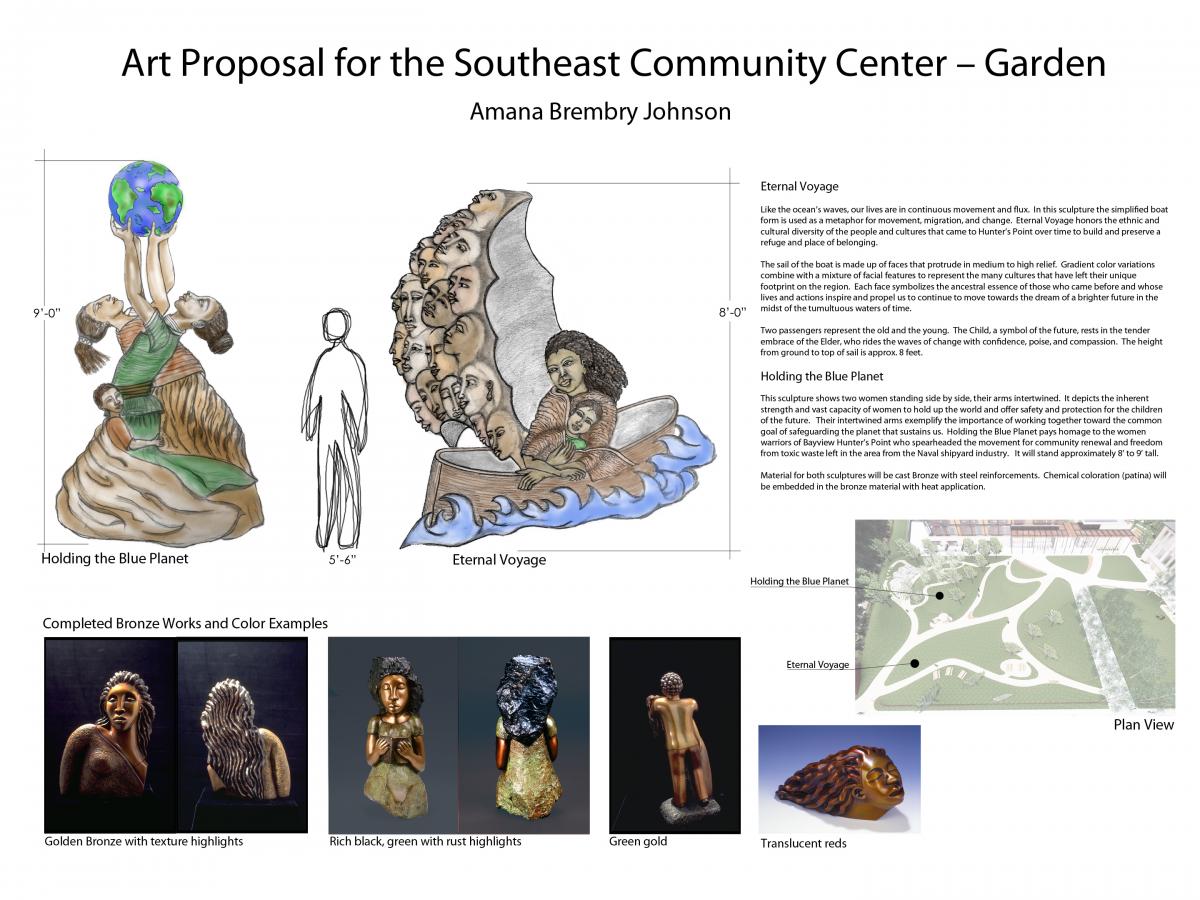 The First Nation people known as the Muwekma Ohlone once inhabited the area now known as Bayview Hunter’s Point. Their presence in the area spanned a period of more than 10,000 years before Western settlers came to the San Francisco Bay Area. They left a blueprint for stewardship and care of the earth and its life sustaining bounty. Over the last 300 years many immigrants and migrant populations would come to partake of the golden riches in the area we now know as Bayview Hunter’s Point.
The First Nation people known as the Muwekma Ohlone once inhabited the area now known as Bayview Hunter’s Point. Their presence in the area spanned a period of more than 10,000 years before Western settlers came to the San Francisco Bay Area. They left a blueprint for stewardship and care of the earth and its life sustaining bounty. Over the last 300 years many immigrants and migrant populations would come to partake of the golden riches in the area we now know as Bayview Hunter’s Point.
Water faring vessels of different types were essential to many of the communities of the area. The Ohlone people constructed Tule boats out of local reeds for fishing. Chinese settlers who came in the 1800s built a thriving shrimp industry with the use of boats propelled by traditional Chinese sails. African Americans fleeing the brutal Jim Crow laws of the south and seeking a kinder more viable life-style migrated to the area in the mid-1900s to work in the naval shipyards during WWII. It is significant to note the paradox in this reconnection of African Americans to water faring vessels, in that African ancestors were brought to the Americas in the ships of the Atlantic Slave Trade.
Drawing from concepts outlined in the San Francisco Master Plan for the Arts, the proposed sculptural works endeavor to acknowledge the history of people and cultures that have contributed to the Hunter’s Point area to make it what we know it to be today.
I have developed concepts that I hope will inspire reflection on the historical trajectory of the area; evoke tenderness and compassion for the children and the world that they will inherit; and to arouse and energize an awareness of the importance of caring for our planet and the environments that sustains life. In these works I have relied upon metaphor rather than literal interpretations of these themes.
Eternal Voyage
Eternal Voyage exhibits a minimalist boat form that serves as a metaphor for the movement and migration of those who settled in the area throughout time. This simple form, recognizable by both children and adults, represents forward movement, change, relocation, and the search for belonging.
The two passengers represent the old and the young. The Child, a symbol of the future, rests comfortably in the experienced arms of the Elder, who rides the waves of change with confidence, poise, compassion, and a steadfast gaze on whatever may arise in the present moment. They will be life-size figures, seated low in the hull of the boat.
The sail is representative of the diverse cultures that have influenced one another and left their unique footprint on the region. The faces that make up the sail symbolize the ancestral essence of those who came before and whose lives and actions propel us to continue to move towards the dream of a brighter future. It’s billowing; fullness signifies the reality of our constant movement through time by the winds of change. The swirling water symbolizes the tumultuous waters of our times.
Location:
I’ve located Eternal Voyage in the wetland area near the Evans and 3rd Street corner entrance. I propose to position it so that the boat’s frontal bow is pivoted slightly portside (to the left). People passing on the street or entering the site will immediately see that both sides of the sculpture have a unique voice and yet neither side will be in full view. It is my intention that this placement may entreat visitors to enter the site, then follow the line of the boat around to discover that there are two separate but related dialogues happening on either side of the sculpture. It will be positioned between the two walkways that lead from 3rd and Evans towards the building.
Dimensions and coloring:
Eternal Voyage will stand approximately 9’-10’ tall. The rim of the hull will hit the adult figure at approximately the upper rib cage. The hull will be 2’ high x 6’5” long x 30” wide. The waves will hug the length of the boat in medium relief on each side, and exceed its length 3” at both front and back of hull. The boat itself will rest on a forward-tilt to affect a sense of movement. The exact tilt will be determined as recommended by a structural engineer. The sail of faces will be attached to the port side of the boat with steel reinforcements also outlined by a structural engineer. The sail coloring will be a blend of translucent, gradient tones of golden-bronze, sienna, red-bronze, and other earth tones that will seamlessly blend into each other and allow the metal’s luminance to shine through. The skin tone of the two figures will complement the colors of the sail. Their garments will be colored with vibrant reds, golden greens, rusty reds, with rich black rubbed into the crevices to accentuate the textured surfaces.
Holding the Blue Planet
The intent of this sculpture is to feature the principles of resilience, strength, and the power of cooperation. This work shows two women working together to support, and reinforce each in the monumental task of both holding up the world, and offering tender and compassionate care to the children of our future. It depicts the vast range of feminine capacity to simultaneously be fiercely protective and benevolently kind.
Their intertwined arms are positioned to exemplify the importance of working together to skillfully overcome adversity. This image represents the women warriors of Hunter’s Point who spearheaded many movements for community renewal, some of which include cleaning up toxic waste left from the shipyards, as well as social and financial equity.
The women are holding up the earth in a gesture of honor and respect for the land and surrounding environment while simultaneously nurturing the future wrapped in the folds of their skirts.
Location:
The proposed placement for this sculpture, as indicated in the plan view, is in the raised wooded area of Boulder Hill. The intent is to place this sculpture a reasonable distance from Eternal Voyage and from the premier sculpture that will be located at the entrance to the facility. There may be a more complimentary placement that achieves this goal.
Dimensions and coloring:
Holding the Blue Planet will stand 10’ tall. The irregularly shaped base, made up of the women’s skirts, will be approximately 4’ x 4’. The women will be 6’ in height to their shoulders. Their outstretched arms will be 24” long, making their total height 8’. The globe will be approx. 30” in diameter. The blues in both the boat and the earth will be heat-applied layers of highly pigmented chemical patina. The reds, rusts, verdigris, browns, and golden greens will be variations of classic bronze patinas.
View a larger image of the proposal.
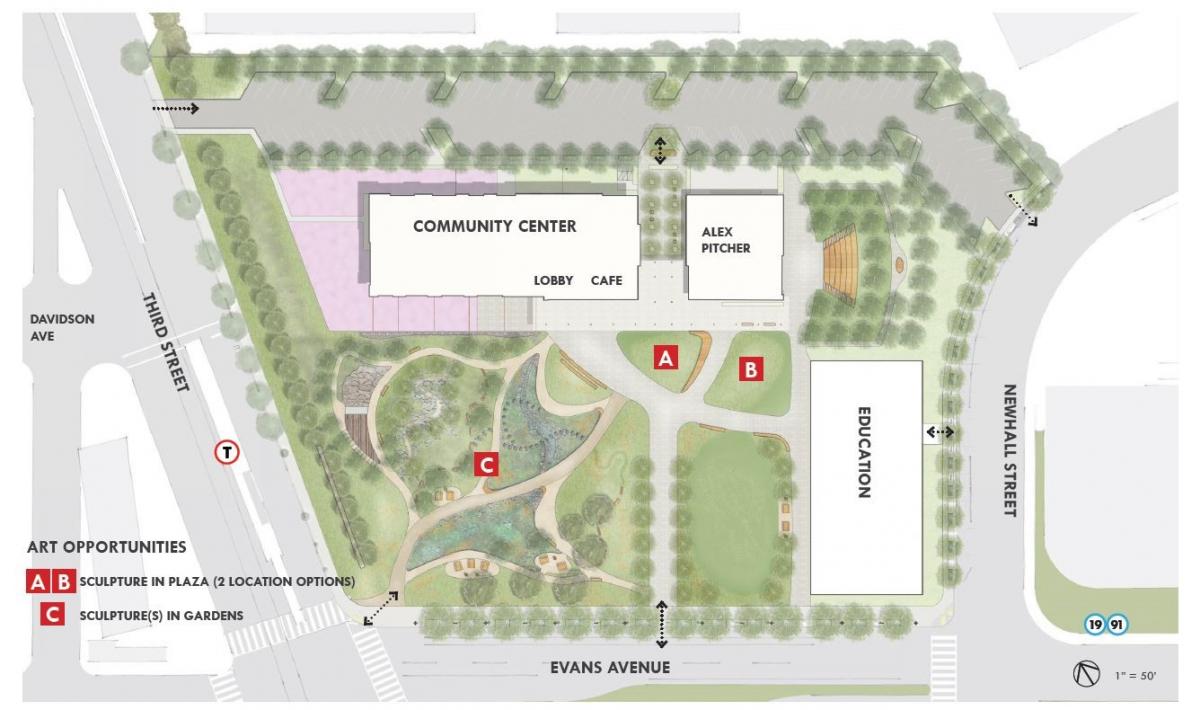 The San Francisco Arts Commission is conducting a selection process to choose sculptural artworks for the outdoor plaza and gardens area at the new Southeast Community Center to be located at 1550 Evans Street. The new Community Center is designed to provide workforce, childcare, and educational opportunities for the Bayview community. The goal of the artwork is to celebrate the Bayview community—its people, values, history, and culture—and to promote environmental stewardship and highlight the importance of the environment to health and prosperity of current and future generations. Four artists were chosen as finalists by a Selection Panel to create site-specific proposals for the Plaza opportunity: Flaming Lotus Girls, Lead Pencil Studio, Alison Saar, and Hank Willis Thomas. Another four artists were chosen as finalists by the same panel to create site-specific proposals for the Gardens: Mildred Howard, Amana Johnson, Dana King, and Joe Sam.
The San Francisco Arts Commission is conducting a selection process to choose sculptural artworks for the outdoor plaza and gardens area at the new Southeast Community Center to be located at 1550 Evans Street. The new Community Center is designed to provide workforce, childcare, and educational opportunities for the Bayview community. The goal of the artwork is to celebrate the Bayview community—its people, values, history, and culture—and to promote environmental stewardship and highlight the importance of the environment to health and prosperity of current and future generations. Four artists were chosen as finalists by a Selection Panel to create site-specific proposals for the Plaza opportunity: Flaming Lotus Girls, Lead Pencil Studio, Alison Saar, and Hank Willis Thomas. Another four artists were chosen as finalists by the same panel to create site-specific proposals for the Gardens: Mildred Howard, Amana Johnson, Dana King, and Joe Sam.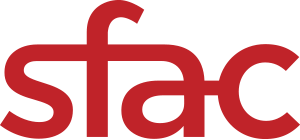
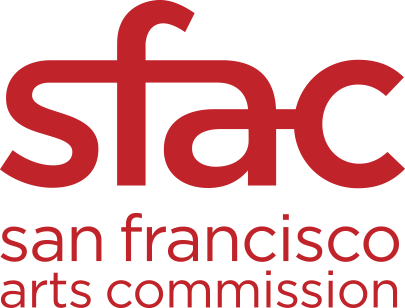

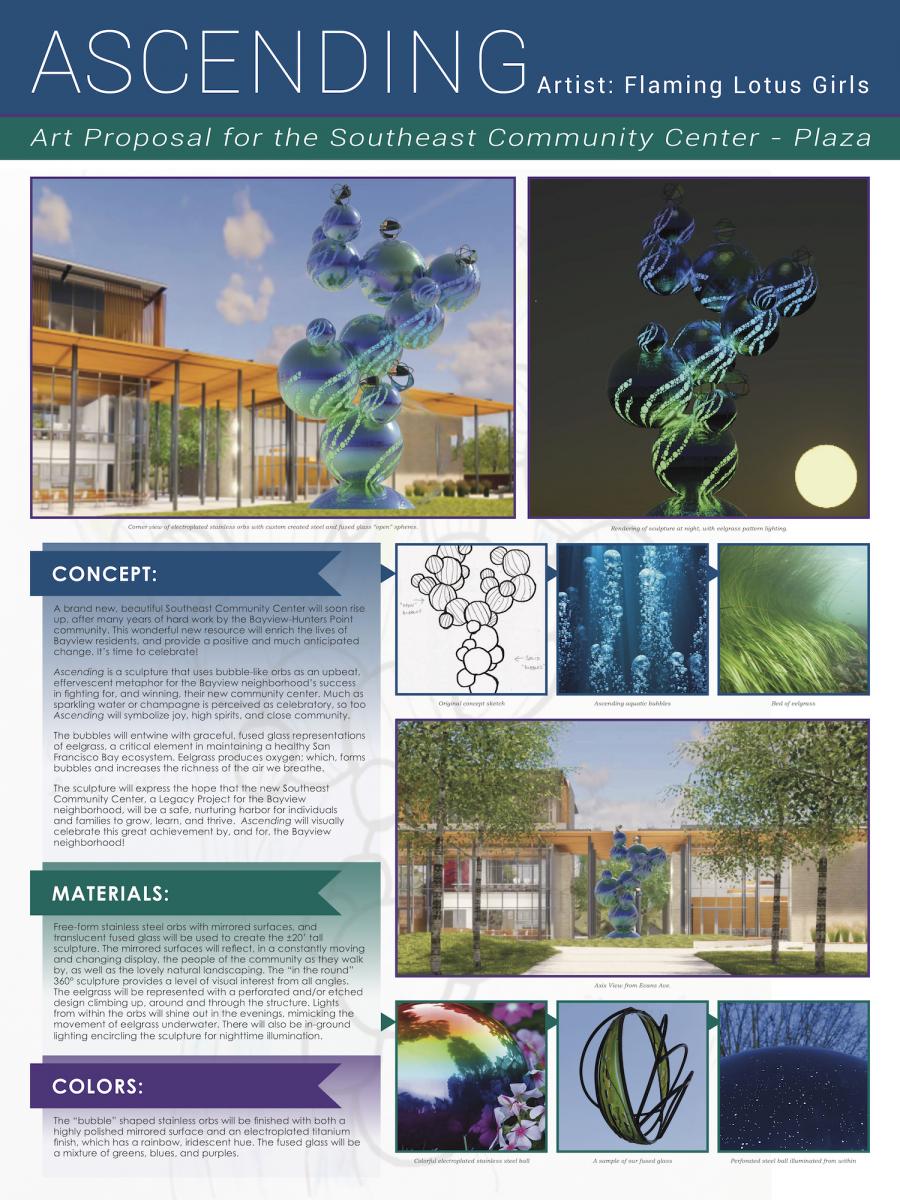 A brand new, beautiful Southeast Community Center will soon rise up, after many years of hard work by the Bayview-Hunters Point community. This wonderful new resource, will enrich the lives of Bayview residents, and provide a positive, much anticipated change. It’s time to celebrate!
A brand new, beautiful Southeast Community Center will soon rise up, after many years of hard work by the Bayview-Hunters Point community. This wonderful new resource, will enrich the lives of Bayview residents, and provide a positive, much anticipated change. It’s time to celebrate! Adding to the SE Community Center’s natural environment is a symbolic tree for the people of Bayview-Hunters Point (BVHP). This 35 foot tall sculpture is both an abstract boundary map of BVHP and a translucently rendered Coastal Live Oak. This resilient indigenous oak tree is a visual reference for the hardship endured by the many minority communities who call this sacred land, home. It is also a map of the many activists who had labored to keep this once overlooked community, healthy, whole and thriving through decades of unrelenting adversity. Tree of Bayview is a celebration and a symbol of this community and a reminder of the physical boundaries defended with citizen participation. Tree of Bayview will serve as a quiet icon for that achievement that creates dazzling patterns on sunny days and brilliant illumination in the evenings at the much anticipated community center.
Adding to the SE Community Center’s natural environment is a symbolic tree for the people of Bayview-Hunters Point (BVHP). This 35 foot tall sculpture is both an abstract boundary map of BVHP and a translucently rendered Coastal Live Oak. This resilient indigenous oak tree is a visual reference for the hardship endured by the many minority communities who call this sacred land, home. It is also a map of the many activists who had labored to keep this once overlooked community, healthy, whole and thriving through decades of unrelenting adversity. Tree of Bayview is a celebration and a symbol of this community and a reminder of the physical boundaries defended with citizen participation. Tree of Bayview will serve as a quiet icon for that achievement that creates dazzling patterns on sunny days and brilliant illumination in the evenings at the much anticipated community center.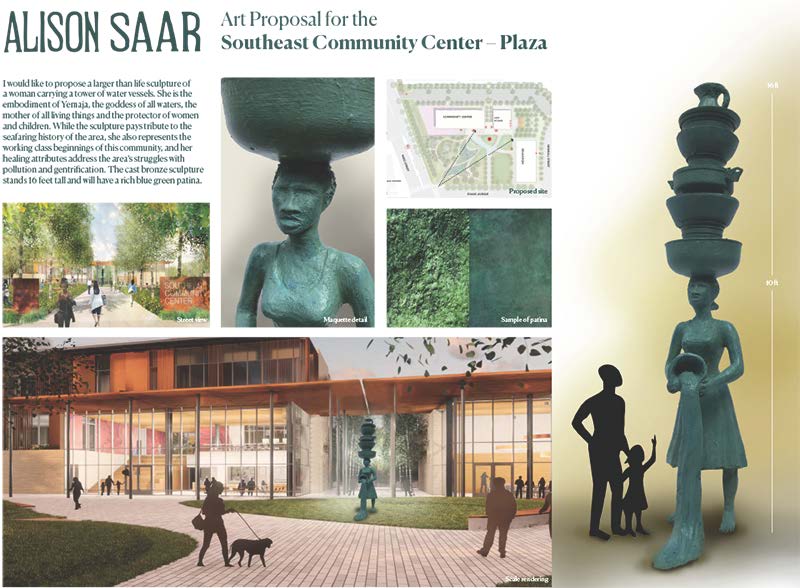 For the Southeast Community Center, I would like to propose a 16 foot tall cast bronze sculpture of a woman carrying water vessels. The figure will stand 10 feet tall and will be balancing a 6 to 7 foot tall tower of various tubs, basins pans and pitchers. She is the embodiment of Yemaja, a Yoruba deity, the goddess of all waters and mother of all living things. Yemaja can be found in throughout Africa and the Americas, she is the protector of women and children and has cleansing and healing attributes.
For the Southeast Community Center, I would like to propose a 16 foot tall cast bronze sculpture of a woman carrying water vessels. The figure will stand 10 feet tall and will be balancing a 6 to 7 foot tall tower of various tubs, basins pans and pitchers. She is the embodiment of Yemaja, a Yoruba deity, the goddess of all waters and mother of all living things. Yemaja can be found in throughout Africa and the Americas, she is the protector of women and children and has cleansing and healing attributes. 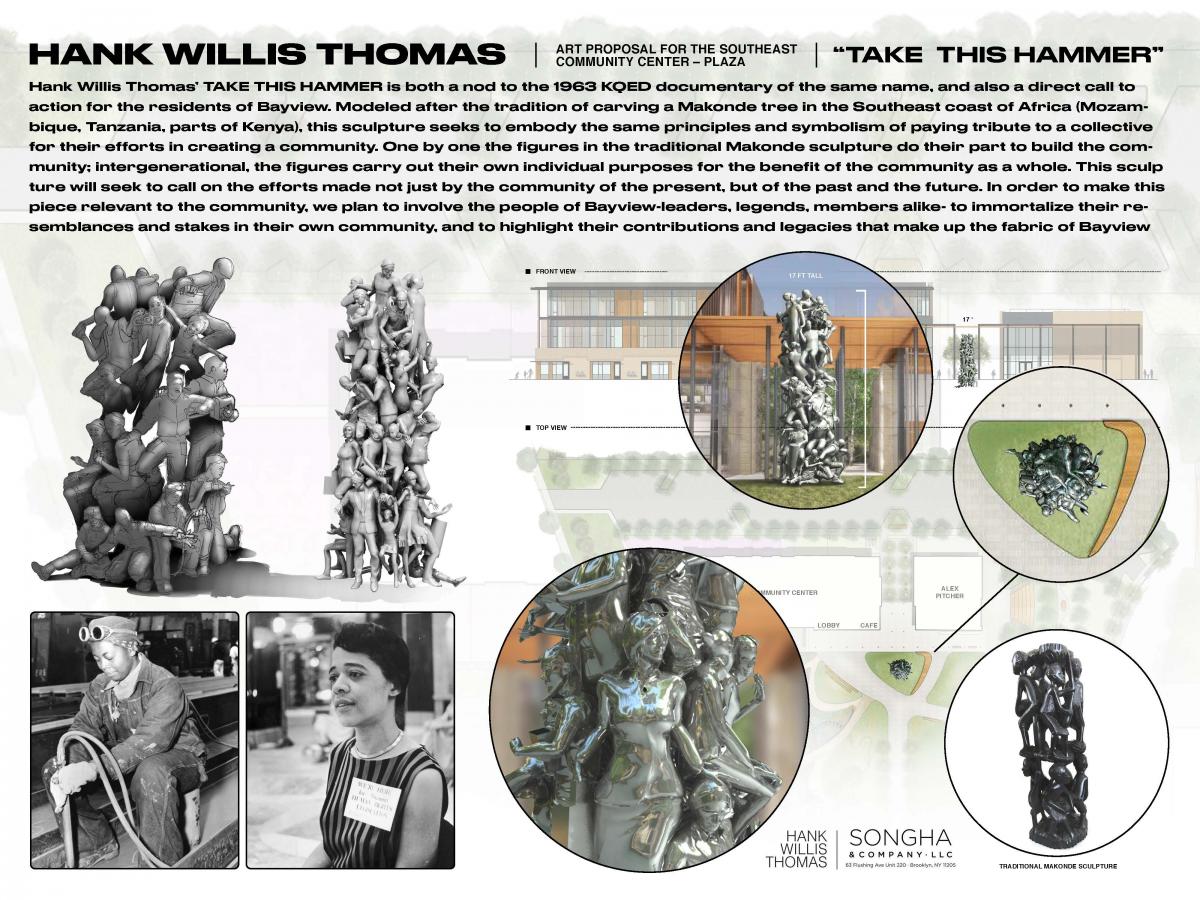 Hank Willis Thomas’ TAKE THIS HAMMER is both a nod to the KQED documentary of the same name, and also a direct call to action for the residents of Bayview. As this classic film followed James Baldwin through communities of the Bay area in 1964, this sculpture will endeavor to engage the community in the same way today.
Hank Willis Thomas’ TAKE THIS HAMMER is both a nod to the KQED documentary of the same name, and also a direct call to action for the residents of Bayview. As this classic film followed James Baldwin through communities of the Bay area in 1964, this sculpture will endeavor to engage the community in the same way today.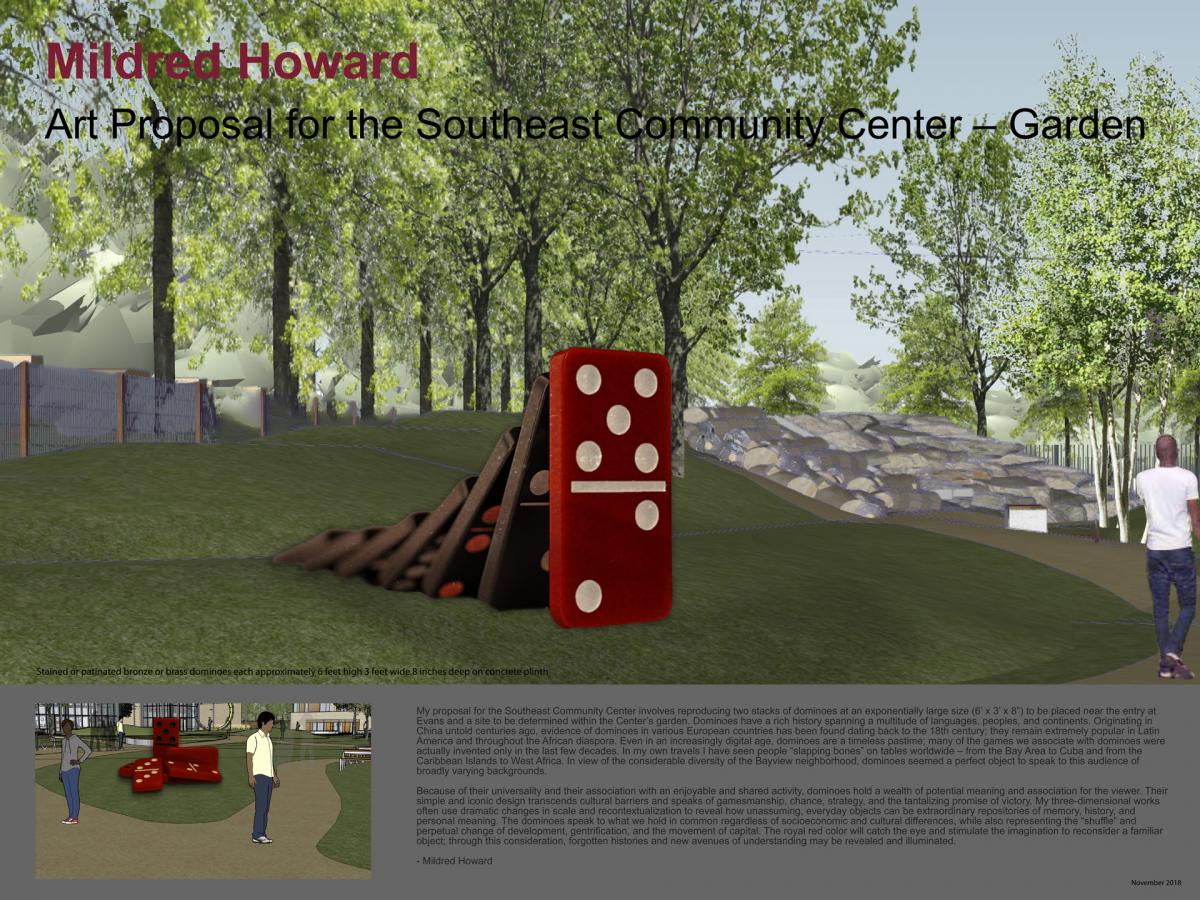 My proposal for the Southeast Community Center involves reproducing two stacks of dominoes at an exponentially large size (6’ x 3’ x 8”) to be placed near the entry at Evans and a site to be determined within the Center’s garden. Dominoes have a rich history spanning a multitude of languages, peoples, and continents. Originating in China untold centuries ago, evidence of dominoes in various European countries has been found dating back to the 18th century; they remain extremely popular in Latin America and throughout the African diaspora. Even in an increasingly digital age, dominoes are a timeless pastime; many of the games we associate with dominoes were actually invented only in the last few decades. In my own travels I have seen people “slapping bones” on tables worldwide – from the Bay Area to Cuba and from the Caribbean Islands to West Africa. In view of the considerable diversity of the Bayview neighborhood, dominoes seemed a perfect object to speak to this audience of broadly varying backgrounds.
My proposal for the Southeast Community Center involves reproducing two stacks of dominoes at an exponentially large size (6’ x 3’ x 8”) to be placed near the entry at Evans and a site to be determined within the Center’s garden. Dominoes have a rich history spanning a multitude of languages, peoples, and continents. Originating in China untold centuries ago, evidence of dominoes in various European countries has been found dating back to the 18th century; they remain extremely popular in Latin America and throughout the African diaspora. Even in an increasingly digital age, dominoes are a timeless pastime; many of the games we associate with dominoes were actually invented only in the last few decades. In my own travels I have seen people “slapping bones” on tables worldwide – from the Bay Area to Cuba and from the Caribbean Islands to West Africa. In view of the considerable diversity of the Bayview neighborhood, dominoes seemed a perfect object to speak to this audience of broadly varying backgrounds. The First Nation people known as the Muwekma Ohlone once inhabited the area now known as Bayview Hunter’s Point. Their presence in the area spanned a period of more than 10,000 years before Western settlers came to the San Francisco Bay Area. They left a blueprint for stewardship and care of the earth and its life sustaining bounty. Over the last 300 years many immigrants and migrant populations would come to partake of the golden riches in the area we now know as Bayview Hunter’s Point.
The First Nation people known as the Muwekma Ohlone once inhabited the area now known as Bayview Hunter’s Point. Their presence in the area spanned a period of more than 10,000 years before Western settlers came to the San Francisco Bay Area. They left a blueprint for stewardship and care of the earth and its life sustaining bounty. Over the last 300 years many immigrants and migrant populations would come to partake of the golden riches in the area we now know as Bayview Hunter’s Point. Children have been playing “Hide and Go Seek” since the beginning of time. It’s an activity that demands a bit of ingenuity, stealth and youthful vigor. But the best part is that it requires an enthusiastic group of friends to join in.
Children have been playing “Hide and Go Seek” since the beginning of time. It’s an activity that demands a bit of ingenuity, stealth and youthful vigor. But the best part is that it requires an enthusiastic group of friends to join in.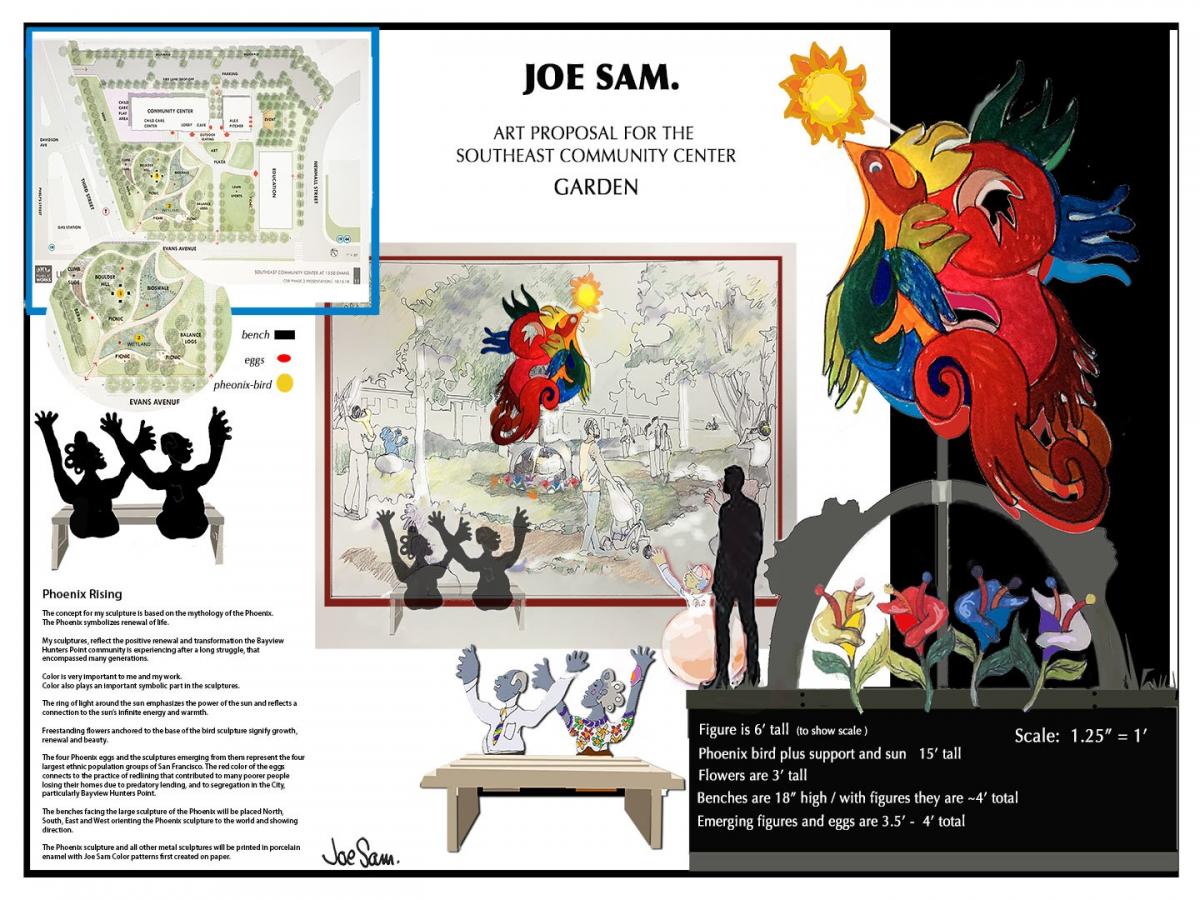 The concept for my sculpture is based on the mythology of the Phoenix.
The concept for my sculpture is based on the mythology of the Phoenix. 
Opportunity For Public Comment
The Final Selection Panel meeting will take place Friday, December 14, 2018, 9 a.m.—3:30 p.m. at 401 Van Ness Avenue, Room 302. All Artist Selection Panel meetings are open to the public. An agenda for the meeting will be posted 72 hours in advance of the meeting on SFAC’s website under the Public Meeting section: https://www.sfartscommission.org/calendar
Comments may be emailed to sfacpublicartcomment@sfgov.org, or hand delivered/mailed to 401 Van Ness Avenue, Room 325 by Wednesday, December 12, 2018 at 5:00 p.m.